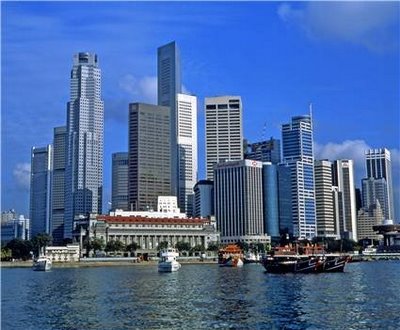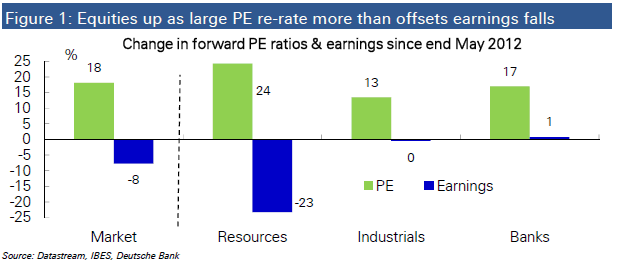Insightful Insights
-

MEDIA
Go against the flow and thrive
Roger Montgomery
October 27, 2012
In this Australian article published 27 October 2012 Roger discusses how behaving counterintuitively may result in better performance for your portfolio. Read here.
by Roger Montgomery Posted in In the Press, Insightful Insights, Investing Education, Market Valuation.
-

Market Correction
Roger Montgomery
October 26, 2012
From Roger Montgomery & Russell Muldoon.
Although we are asked regularly to give our opinion on where we think the stock market is heading, we are loathe to make such predictions because we simply don’t know how to accurately and consistency forecast short term share prices. As you know, we believe that in the short run share prices are moved by unintelligent and emotionally unstable influences and these are unpredictable.
Furthermore, it’s the performance of the businesses that we hold that will determine the return to our investors over the longer run because over longer periods of time, prices follow business performance. The direction of largest two hundred market-weighted stocks that make up the index are not going to help us so predicting the direction of the index is a bit of a waste of time. Usually.
On a few occasions throughout the years, we have sounded a cautionary alarm when the aggregate market price of our portfolio is either at, or has exceed, the valuations of its constituents.
This week, of the 16 completed holdings in The Montgomery [Private] Fund, more than half are now trading at, or in excess of our assessment of fair value. This is the result of strong price appreciation in the past two months.
by Roger Montgomery Posted in Insightful Insights.
- 5 Comments
- save this article
- POSTED IN Insightful Insights
-

Now we can really call ourselves ‘Down Under’
David Buckland
October 24, 2012
I was interested to read the recommendations from Infrastructure Australia of selling $220 billion of “lazy assets owned by the federal and state governments to plug the nation’s infrastructure gap, reduce debt and lift productivity”. 82 profit-making government assets could be sold relatively quickly, according to the report.
Meanwhile, I hope our nations political leaders are paying attention to another report; one which puts Australia’s positioning into a global context. According to the World Economic Forum, Australia has slipped in terms of the global competitiveness index, from 16th place (out of 142 countries) in 2010/2011 to 20th place in 2011/2012. In terms of quality of infrastructure we rank a disappointing 37th place, with the quality of our ports coming in at 40th place, a travesty for an island continent dependent on commodity exports.
While Australia ranks highly in health and education, in the category of “burden of government regulation”, Australia unsurprisingly is placed below half-way in 75th place.
Regarding key performance indicators (KPI’s) for our political leaders, I believe their focus should be on laying out and executing a plan for taking Australia from 20th place in the global competitiveness index to a top ten place over the balance of this decade.
by David Buckland Posted in Insightful Insights.
- 1 Comments
- save this article
- POSTED IN Insightful Insights
-
Where is the value? Let Skaffold keep you posted!
Roger Montgomery
October 22, 2012
Last week on 2GB I didn’t speak to Ross Greenwood as I normally do. He was off in New York for Channel Nine. Instead I had a terrific chat with my friend and former fund manager Matthew Kidman.
As usual we didn’t have a great deal of time but I asked Matthew whether he was seeing much value and his reply was telling. Like me, it seems to Matthew that value was getting thin on the ground, particularly among the higher quality companies.
There is still a few pockets of value and we named a few stocks. Matthew mentioned that he also predicted that the market would now strengthen and stocks that are fairly valued may continue to rally well beyond fair value.
I am less able to predict stocks and their short term price direction. To reduce risk what we do is simply analyse those companies that come into value as their prices, values and quality scores change.
by Roger Montgomery Posted in Companies, Insightful Insights, Intrinsic Value, Skaffold.
-

Where is the ‘Fat Controller’?
Roger Montgomery
October 18, 2012
Yesterday Marius Kloppers was reported in the Oz as saying “the record prices we experienced over the past decade, driven by the ‘demand shock’, will not be there to support returns over the next 10 years”
Additionally he revealed that the mining industry collectively has not learned anything from past booms and busts when he explained that to meet the rising demand mining companies had yet again taken a “volume over cost” approach, adding “improving productivity played second fiddle to speed to market for many in the industry”.
While we can give ourselves a little ‘we-said-it-here-first’ pat on the back for spotting the coming slump in iron ore prices a year ago and protecting our investors from it, the bigger picture is more important; Where is the industry’s equivalent of the Thomas the Tank character – the Fat Controller? Why is there no ‘OPEC’ for iron ore and coal producers? Would it help if there was?
The lessons of each boom/bust cycle are lost with each generation’s death and the mistakes repeated again. Only those who study history can hope to beat this cycle because caught in its spotlight are prone to declare this time is different.
An argument we heard this time was “it can’t fall below $100/t because China’s cost of production is higher”. Yet anyone with more than a few minutes experience in commodity markets can tell you that just about every commodity has traded below its cost of production and sometimes for many years.
While we believe we are able to spot these cycles developing, we must ask the question, what will be put in place to ensure that next time billions are again not wasted? Or is this the ugly wart on capitalism’s nose that cannot be removed?
by Roger Montgomery Posted in Energy / Resources, Insightful Insights.
-
Waiting on Earnings Growth
David Buckland
October 17, 2012
Since June 2012, the ASX 200 Index has risen from a low of 4,000 points to the current 4,500, despite the deteriorating global growth outlook. In a research paper from the Strategist at Deutsche Bank, Tim Baker points out this 12.5% rally is based on a 20% expansion in the Australian prospective PE ratio from 10.7X to 12.8X over this period. In fact forecast earnings over this period has declined by 8% while the Resource Sector has recorded a 23% decline in its forecast earnings. The ratio of downgrades to upgrades is running at 2 to 1. Despite brokers using the Earnings Yield (7.8%) to Bond Yield (3.0%) Gap (4.8%) as an argument to buy the market, earnings growth will need to come through at some stage for the rally to continue.
by David Buckland Posted in Insightful Insights.
- 6 Comments
- save this article
- POSTED IN Insightful Insights
-

MEDIA
What is Russell Muldoon’s outlook on Commodities?
Roger Montgomery
October 17, 2012
Do CSL (CSL, Silverlake (SLR), FKP (FKPDA), Breville Group (BRG), Codan (CDA), QBE Insurance (QBE), NAB (NAB), Wesptac (WBC), AMP (AMP), ALS (ALQ), Prima (PRR), Rio Tinto (RIO), Lynas (LYC), or Mesoblast (MSB) achieve the coveted A1 grade? Watch this edition of Sky Business’ Your Money Your Call 17 October 2012 program now to find out, and also learn Russell’s insights into the commodities sector. Watch here.
by Roger Montgomery Posted in Companies, Financial Services, Insightful Insights, Intrinsic Value, TV Appearances.
-

Iluka confirms all our fears…
Roger Montgomery
October 16, 2012
Didn’t think a free blog could be a valuable use of your time?
Back on 13 July 2012 (read here), we warned that Iluka Resources announced their 2012-2014 Key Physical and Financial Guidance previously released in February 2012 was “now redundant and as such no longer applicable”. Management had said volumes for the December 2012 half-year were indicating “lower ordering patterns or an unwillingness to commit to volumes except on an “as needed” basis”.
As with other miners described here at the blog over the last year, the boom appeared to be over and reports were confirming our earlier appraisal of the likely impact from a China – led slowdown. Iluka’s exposure is both direct and indirect and the grim conditions were confirmed yesterday with the release of the Iuka Resources September Quarterly report. Combined sales volumes of zircon, rutile, synthetic rutile and ilmenite at 306,300 tonnes, were down 29% on the September Quarter 2011. Revenue at $225m was down an extraordinary 58% from $533m recorded in the September Quarter 2011. This means the average selling price for Iluka’s mineral sands declined by 41% year on year. In response, the Iluka share price fell 6.6% to $9.00 and is back to trading where it was in February 2011. Essential reading indeed.
by Roger Montgomery Posted in Companies, Insightful Insights.
- 3 Comments
- save this article
- POSTED IN Companies, Insightful Insights
-

Singapore 1, Australia Nil.
Roger Montgomery
October 15, 2012
The front page of Today’s Fin Review reports that Australia is losing ground against Asian competitors in its plan to be a ‘financial hub’.
As many of you know I reported here back in July after my visit to Singapore that Australia has zero chance of being a financial hub. A “hub” must be at the centre of a wheel to work. Geographically Australia is about as much a hub as a cul de sac is a junction. Australia is geographically disadvantaged. Its is far from everywhere.
As a result Australia must do even more than its neighbours to encourage immigration of the best and brightest. Its must be more generous with its tax structure and it must do more than its neighbours in innovating the education system.
But the fact that Australia is losing the ‘financial hub’ race is a reflection of so much that is wrong with the management of our many amazing resources.
Australia lost its chance to be a financial hub and in fact advertised to the world that it didn’t want to be, years ago, when Deutsche Bank offered to set up its Asian Headquarters here but requested tax concessions. The government – in its typically big picture, long term thinking – was not forthcoming.
Australia cannot and and will not become a financial hub of Asia because it missed its chance.
Any visitor to Singapore can see why no large global and profit-motivated financial institution would leapfrog Singapore to set up in Australia. And its not just because their press is controlled and their political system stable. First, their tax structure is much more attractive (it can be), secondly; labour can be supplied at very cheap rates (another by-product of geographic proximity to cheap sources) allowing full time focus on more productive and higher value endeavours. Third, disincentives such as high taxes on motor vehicles (The COE renders a VW Polo ($19,000 in Oz) a $120,000 car in Singapore) and levies on locals visiting the two casinos has allowed the government to fund the build of one of the world’s most efficient and attractive mass transit systems and now serious dollars are being tipped into the development of an underground road network. Singapore will have built a complete underground road network, a secure, safe, attractive and expanding mass transit system while Sydney will still not have solved congestion on the spit bridge.
Singapore is getting things done and that’s the fourth thing that attracts competitively minded organisations.
This paragraph from Singapore’s Tax Portal tells the story of how they are encouraging new businesses to set up, to innovate and to create jobs.
“The tax exemption scheme for new start-up companies was introduced in Year of Assessment (YA) 2005 to support entrepreneurship and to help our local enterprises grow.
Under this scheme, a newly incorporated company that satisfies the qualifying conditions can claim for full tax exemption on the first $100,000 of normal chargeable income* (excluding Singapore franked dividends) for each of its first three consecutive YAs.
Starting from YA 2008, a further 50% exemption is given on the next $200,000 of the normal chargeable income* (excluding Singapore franked dividends) for each of the first three consecutive YAs.”
So a new business gets a tax holiday on the first $100,000 of profit for the first three years and the next $200,000 is taxed concessionally. Thats up to $900,000 of seriously low tax rates over three years.
Expats in Singapore enjoy cheap airfares to Thailand, Malaysia, Bali, Cambodia and many other exotic locations and this is an appealing benefit for large corporations to consider when relocating staff.
We need leaders in Canberra not politicians. We have so much to offer and yet we are dropping the ball. The 24-hour news cycle ensures that Canberra is distracted from the main game by things of vanity and childish pride rather than enduring changes of long term strategic significance. A hundred years ago our leaders didn’t have to worry about their every utterance being plastered on the front page or on that evening’s news, or if it was, not too many were going to see it or hear about it anyway. They could focus on managing the country and had the space to think strategically.
Today, both major parties send teams of researchers to America not to discover secrets of productivity or tax efficiency but to learn and import the latest smear techniques to apply against their opponents. With the media reporting every utterance, we are systematically destroying our global competitiveness and this will cost our children dearly. The 24-hour news cycle produces pandering and has resulted in the tail wagging the dog and I for one am tired of it. The main game has become managing the media image not managing the country.
The government talks of improving productivity but instead we ensure low productivity and woeful innovation will be entrenched for years. We only need to look beyond the tax structure to the education system, as well as the distraction of teachers by the online comparison of school performance (something Singapore is dismantling after 20 years), to see that not much will improve in the foreseeable future. Our tax system stifles innovation and entrepreneurship and ensures the best and brightest export their ideas, their job hires and their business and revenue growth to Silicon Valley or Asia. Our public education promotes mediocrity and offers few opportunities for the brightest kids. Pecking orders among trenched teachers crush the enthusiasm of the new system ensures there will be no innovation in the tax system.
If we are serious about the future of our country much needs to change. But it is not happening because our leaders are not leading. They’re wasting our time and theirs and undeserving of our trust. What parent would point to a politician and tell their child; “if you work hard and study, you could be one of them one day”. The reputation of the office has been tarnished because it is ineffective.
Singapore 1, Australia Nil.
by Roger Montgomery Posted in Insightful Insights.
- 12 Comments
- save this article
- POSTED IN Insightful Insights
-

MEDIA
Seeking Healthy Results for All
Roger Montgomery
October 13, 2012
Roger discusses his best picks in the healthcare sector in his Australian article published on 13 October 2012. Read here.
by Roger Montgomery Posted in Health Care, In the Press, Insightful Insights.
- save this article
- POSTED IN Health Care, In the Press, Insightful Insights
